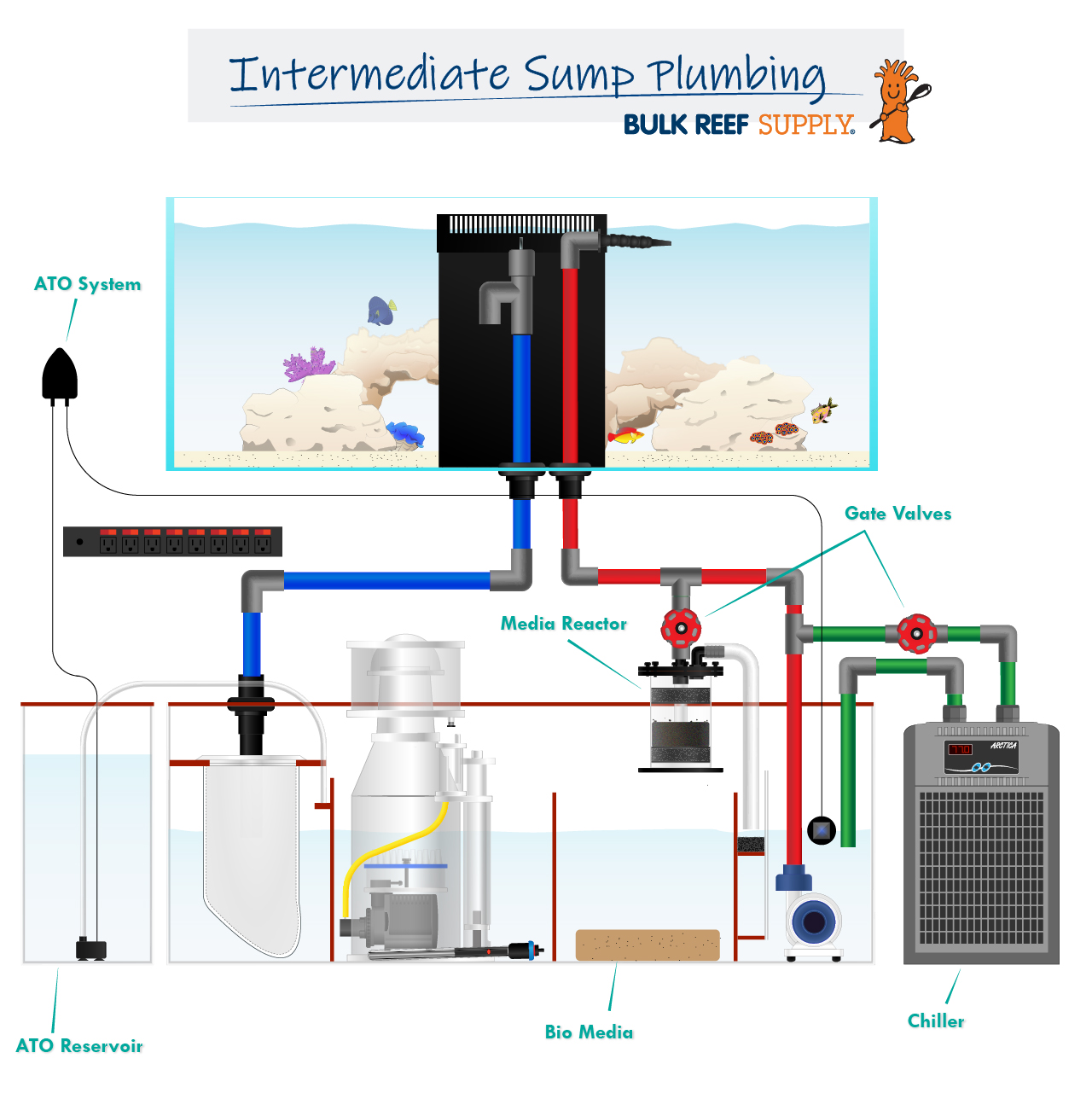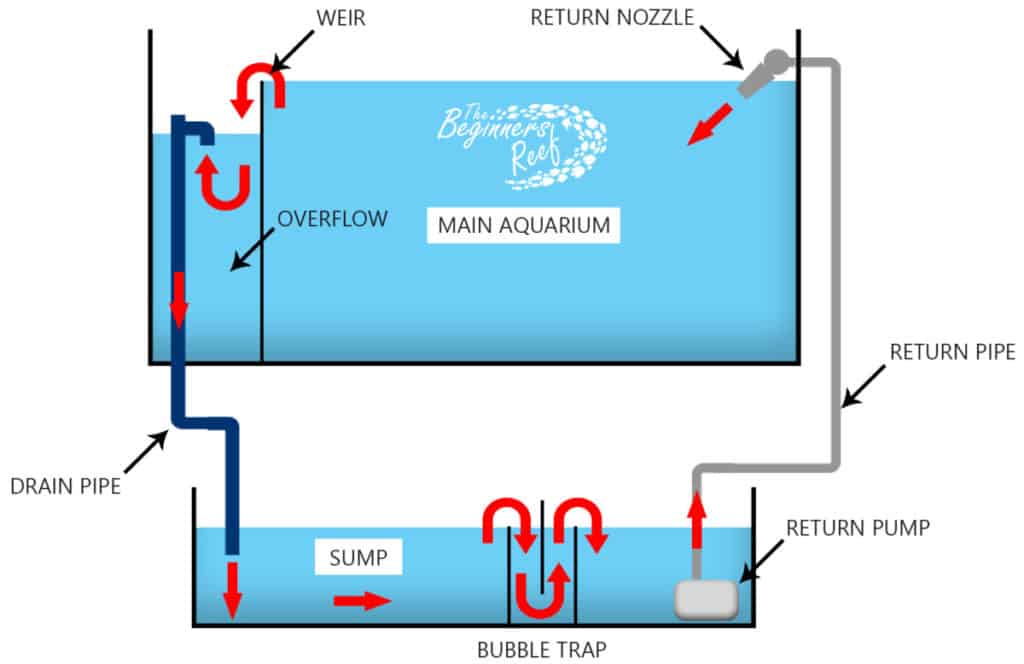Originally posted on May 15, 2023 @ 1:00 pm
Last Updated on 4 months by admin
Are you a freshwater aquarium enthusiast who wants to take your hobby to the next level? Do you struggle to understand the complex and intricate workings of sump diagrams? Look no further! In this comprehensive guide, we will break down the various components of freshwater aquarium sump diagrams and provide you with a clear understanding of how they work together to create a healthy and thriving aquatic environment.
From basic sump design principles to advanced filtration techniques, this guide will equip you with the knowledge and skills necessary to design and maintain your own custom sump system. Whether you’re a beginner or a seasoned aquarium keeper, this guide will help you unlock the full potential of your freshwater aquarium and take your hobby to the next level. So, let’s dive in and explore the fascinating world of freshwater aquarium sump diagrams!

A Comprehensive Guide to Understanding Freshwater Aquarium Sump Diagrams
For those looking to maintain a healthy and thriving freshwater aquarium, understanding the ins and outs of a sump diagram is crucial. A sump diagram is essentially a map of the filtration system that keeps your tank clean and healthy. In this article, we’ll take a comprehensive look at what sump diagrams are, how they work, and how to create one for your own aquarium.
What is a Freshwater Aquarium Sump?
A freshwater aquarium sump is a filtration system that is designed to remove debris and waste from your fish tank. It is essentially a separate container that houses various filtering media, such as bio-balls, foam pads, and activated carbon. Water from your aquarium is pumped into the sump, where it passes through these filtration materials before being returned to the tank. Sumps can be either DIY or pre-made, and they can be customized to fit the specific needs of your aquarium.
Benefits of a freshwater aquarium sump include increased water volume, which helps to dilute toxins and waste; improved water flow and circulation; and the ability to hide equipment such as heaters, protein skimmers, and pumps. Additionally, sumps can be customized to include additional features such as refugiums, which can help to improve water quality by providing a natural environment for beneficial microorganisms and algae.
How to Create a Freshwater Aquarium Sump Diagram
Creating a sump diagram can seem overwhelming at first, but it’s actually a fairly simple process. The first step is to determine the size and dimensions of your sump. This will depend on the size of your aquarium and the amount of filtration you need. Once you’ve determined the size of your sump, you can begin to plan out the different compartments and filter media that you’ll use.
One popular configuration for a freshwater aquarium sump is the three-chamber design. The first chamber houses mechanical filtration materials such as foam pads or filter floss. The second chamber contains biological filtration materials such as bio-balls or ceramic media. The third chamber can be used for additional filtration or as a refugium.
When creating your sump diagram, it’s important to consider the flow rate of your pump and the turnover rate of your aquarium. These factors will determine the size of your plumbing and the diameter of your tubing. You’ll also need to consider the placement of your equipment such as heaters and protein skimmers, and plan out how water will flow through each compartment of the sump.
Freshwater Aquarium Sump Diagram vs. Canister Filters
While canister filters are a popular option for aquarium filtration, they are not as efficient as sumps. Canister filters rely on a single filter media, while sumps allow for multiple types of media to be used, increasing the overall filtration capacity. Additionally, sumps provide a larger water volume and improved water flow, which can help to prevent dead spots and stagnant water. Sumps also offer the ability to customize and upgrade your filtration system as needed.
Overall, a freshwater aquarium sump diagram is an essential tool for maintaining a healthy and thriving aquarium. By understanding the basics of sump design and creating a diagram that works for your specific needs, you can ensure that your fish and plants thrive in a clean and healthy environment.
| Pros | Cons |
|---|---|
| Increased water volume helps to dilute toxins and waste | Can be more expensive than canister filters |
| Improved water flow and circulation | Requires additional plumbing and space |
| Ability to hide equipment and customize filtration | Requires some DIY skills to build |
| Can include additional features such as refugiums | May require more maintenance than other filtration methods |
- Pros:
- Increased water volume helps to dilute toxins and waste
- Improved water flow and circulation
- Ability to hide equipment and customize filtration
- Can include additional features such as refugiums
- Cons:
- Can be more expensive than canister filters
- Requires additional plumbing and space
- Requires some DIY skills to build
- May require more maintenance than other filtration methods
Frequently Asked Questions
Here are some common questions people have about understanding freshwater aquarium sump diagrams.
What is a freshwater aquarium sump diagram?
A freshwater aquarium sump diagram is a visual representation of the equipment and plumbing used in a sump system for a freshwater aquarium. It shows where the water enters and exits the sump, as well as the location of various components such as protein skimmers, heaters, and return pumps. Understanding this diagram is essential for setting up and maintaining a sump system.
It is important to note that sump diagrams can vary depending on the specific setup and equipment used, so it is crucial to refer to the diagram provided with your own equipment or consult with a professional if you have any questions or concerns.
What are the benefits of using a sump system in a freshwater aquarium?
A sump system can provide several benefits for a freshwater aquarium. It can increase the water volume in the tank, which can help dilute any toxins or pollutants in the water. It can also provide a place to hide equipment and help maintain a clean and clutter-free aquarium. Additionally, a sump system can offer a way to customize the filtration system to your specific needs and preferences.
However, it is important to note that setting up and maintaining a sump system can be more complicated and expensive than using traditional filtration methods, so it is not always necessary or practical for every aquarium.
What equipment is typically included in a freshwater aquarium sump system?
A freshwater aquarium sump system can include a variety of equipment depending on the specific needs of the aquarium. However, some common components include a protein skimmer, heater, return pump, and mechanical and biological filters. Other possible additions include a refugium, dosing pumps, and UV sterilizers.
It is important to choose high-quality equipment that is appropriate for the size and needs of your aquarium, as well as to properly maintain and clean the equipment to ensure optimal performance.
How do I set up a freshwater aquarium sump system?
Setting up a freshwater aquarium sump system can be a complicated process, so it is important to thoroughly research and plan before beginning. Some general steps include selecting the appropriate equipment, determining the size and location of the sump, and designing the plumbing and filtration system. It is also important to properly cycle the system and monitor water parameters regularly to ensure a healthy and stable environment for your fish and other aquatic life.
If you are unsure about any aspect of setting up a sump system, it is recommended to consult with a professional or experienced hobbyist for guidance and support.
How do I maintain a freshwater aquarium sump system?
Maintaining a freshwater aquarium sump system involves regular monitoring and cleaning of the equipment and water parameters. Some tasks may include weekly water changes, cleaning mechanical filters, adjusting protein skimmer settings, and checking for leaks or other issues. It is also important to regularly test water parameters such as pH, ammonia, nitrite, and nitrate to ensure they are within a healthy range for your fish and other aquatic life.
Additionally, it is important to regularly inspect and maintain the plumbing and electrical components to ensure they are functioning properly and safely. Proper maintenance and care can help ensure the longevity and effectiveness of your sump system and the health and longevity of your aquatic life.

A beginner’s guide to setting up a freshwater sump!
In conclusion, a freshwater aquarium sump diagram is an essential tool for any aquarium enthusiast. It helps to ensure that your aquarium is running smoothly by providing a place for filtration, heating, and other equipment to be housed. By understanding the different components of a sump diagram, you can better maintain the health and well-being of your aquatic pets.
One of the most important things to keep in mind when working with a sump diagram is to ensure that it is properly installed and maintained. Regular cleaning and maintenance of your sump can help to prevent any issues from arising and ensure that your aquarium remains in top condition.
Overall, understanding freshwater aquarium sump diagrams can be a key factor in creating a healthy and thriving aquatic environment. With the right knowledge and tools, you can provide your fish with a safe and comfortable home that they will enjoy for years to come.
